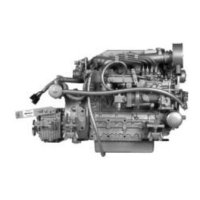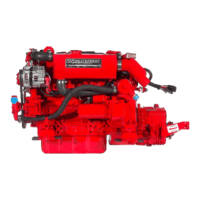)
Engine Break"n Procedures
Although your engine
has
experienced a
minimum
of
one hour
of
test operations
to
ensure accurate
as-
semblyand proper operation of all
systems,
break-in
time
Is
required.
The
service
life
of
your
engine
is
de-
pendent
upon
how
the engine
Is
operated
and
serviced during its initial 50 hours
of
use.
Your
new
engine requires approximately 50
hours
of
initial conditioning operation
to
break
in
each
moving
part in order
to
maximize the performance
and
service life
of
the
engine.
Perform
this conditioning careful-
ly,
keeping
in
mind the following:
1. Start
the
engine
according
to
the
"STARTING
PROCEDURE"
section
found
in
this
manual.
Run
the
engine
at fast
idle
while
checking
that
all
systems
(sea
water
pump,
oil
pressure,
battery charging)
are functioning.
2. Allow
the engine.to
warm
up (preferably
by
running at fast
idle)
until
the
water
temperature
gauge
moves
into the 130-140" F
range.
3. Whle using the vessel,
run
the
engine at varying engine
speeds
for the
first
25 hours.
4.
Avoid
rapid acceleration, especially with a cold engine.
5.
Use
caution not
to
overload
the
engine.
The presence
of
a gray
or
black exhaust. and the
inabDity
of
the
engine
to
reach Its
full
rated
speed,
are
signs
of
an
overload.
6.
DurIng
the
next 25 hours,
the
engine
may
be operated at varying
engine
speeds.
with short
runs
at full
rated
rpm.
.Avoid
prolonged idling during this break-in period.
Brealdng-in
a
new
engine basically
involves
seating
the
piston rings to
the
cylinder walls. This cannot be ac-
complished
by
long periods
of
running
at
Idle,
nor by earfy running at
full
rpm.
Idle
running
may glaze the cylinder
walls,
resutting
in excessive
aD
consumption and smoky operation.
ex-
cessive
speed
or
heavy ovedoading,
especially
with a cold
engine,
may
cause
scoring of the cylinder
walls,
producing similar results.
As
indicated above, operate the
engine
in moderation during
the
5O-hour
break-in
period. (Don't
baby
the
engine, but do not abuse it).
~
WESTERBEKE
Engines & Generators
15

